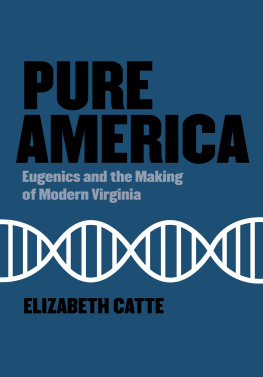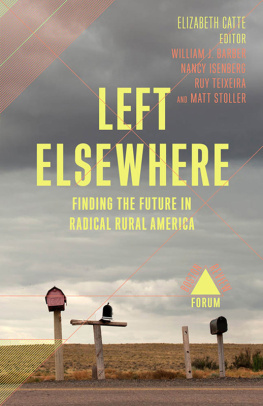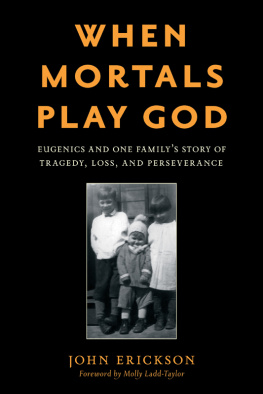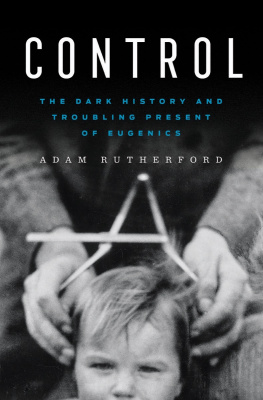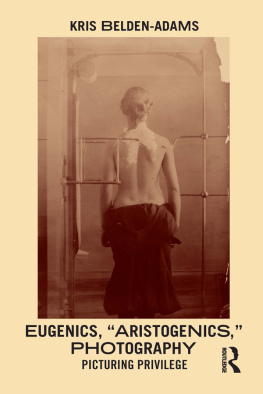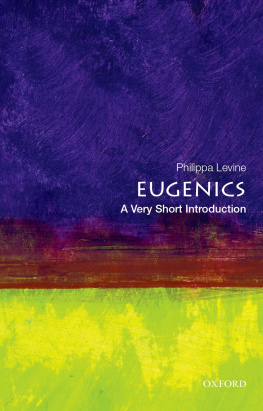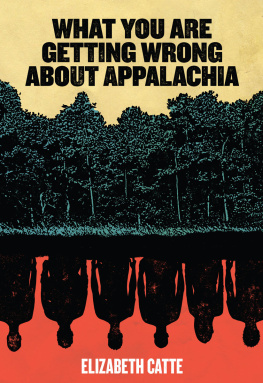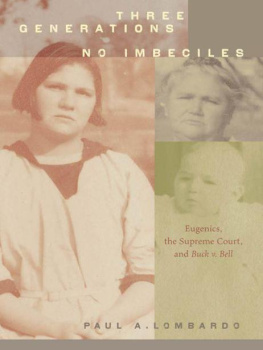
Praise for Elizabeth Cattes
What You Are Getting Wrong About Appalachia:
Small presses across Appalachia and the Rust Belt consistently publish, to little fanfare, incredibly diverse workbooks that are lush, gritty, surprising and so very true. Perhaps the best example, or certainly the best place to begin, is Cattes What You Are Getting Wrong About Appalachia. This edgy, meticulous work of nonfiction from Clevelands Belt Publishing dispels many myths about the region. Leah Hampton, Los Angeles Times
Cattes slim, very readable volume is like a more focused version of Howard Zinns venerable A Peoples History Of The United States, turning its lens to the on-the-ground civic struggles of people who have lived and died in Appalachia.Laura Adamczyk, The A.V. Club
A brief, forceful, and necessary correction. Frank Guan, Bookforum
You couldnt kill this book with a hammer. Come and watch Elizabeth Catte clip the hollow wings of little jimmy vance. Stay and behold an enlightened vision, a living solidarity found among the strong and varied peoples of this misunderstood land.Glenn Taylor, author of The Ballad of Trenchmount Taggart
What are we getting wrong about Appalachia? A lot. This is a necessary antidote to the cyclical mainstream interest in Appalachia as a backwards, white working-class caricature.Tressie McMillan Cottom, author of Thick
A bold refusal to submit to stereotype.Kirkus Reviews
Succeeds in providing a richer, more complex view of a much-maligned region.Publishers Weekly
PURE AMERICA
Eugenics and the Making of Modern Virginia
Elizabeth Catte

Belt Publishing
Copyright 2021 by Elizabeth Catte
All rights reserved. This book or any portion thereof may not be reproduced or used in any manner whatsoever without the express written permission of the publisher except for the use of brief quotations in a book review.
Printed in the United States of America
First edition 2021
1 2 3 4 5 6 7 8 9
ISBN: 978-1-948742-73-3
Belt Publishing
5322 Fleet Avenue
Cleveland, Ohio 44105
www.beltpublishing.com
Cover art by David Wilson
Book design by Meredith Pangrace
TABLE OF CONTENTS
A NOTE ON LANGUAGE AND CONTENT
T his book repeats some ugly and abusive language that historical actors invented to describe people perceived to have disabilities in the past. Much of this language is specific to the outlook held by physicians, lawmakers, and laypeople who lived in the early twentieth century. In this period, labels such as feebleminded, unfit, and defective had clinical understandings, but these terms were also applied broadly and in derogatory ways to describe people with presumed shortcomings of character. In many examples that appear in this book, historical actors used their language of disability to describe people that we would not consider disabled today.
In No Right to Be Idle: The Invention of Disability 1840s1930s, historian Sarah F. Rose writes, the experience of disability, and even what counts as a disability, varies by historical era and culture. The ways in which race, class, gender, age, and kind of impairment intersect with disability also matter, of course. In some contexts, it is relevant to emphasize that many of the victims of eugenics and forced sterilization were not disabled according to our contemporary use of the term. But capturing the ways that perceptions of disabilities shift with time and place does not mean the primary injustice of eugenics was that it ensnared so-called normal people. Rather, the shifting nature of these perceptions and the realities that followed underscore that there is a long history in America of imprinting racial, gender, and class prejudices onto the concept of disability.
For readers who want more information about these ideas, including the ways that they continue to circulate today, there is a list of suggested resources at the back of this book.
INTRODUCTION
T his is a book about eugenics, which is to say it is a book about my neighborhood. When I started writing Pure America, I lived on one of the more elevated streets in Staunton, Virginia, a small city nestled in the Shenandoah Valley. For years, my daily routine played out in exactly the same way: Id leave my apartment, coast down the hill a quarter of a mile toward Richmond Avenue, Stauntons main thoroughfare, and catch a traffic light that put me nose to nose with the original campus of Western State Hospital, where, between 1927 and 1964, surgeons sterilized around 1,700 people without their consent.
When I describe the hospital like that, you might conjure up an image of my daily commute that seems ripped from the mind of Shirley Jackson: Western State, not sane, stood by itself against the hills, holding darkness within. But instead, what I came nose to nose with every day was a bustling construction project. The sitean assembly of buildings and land, including a cemetery that contains the remains of as many as 3,000 former patientswas being diligently transformed into a luxury hotel and an upscale property development marketed to retirees and second-home buyers.
In other words, Western State did not stand by itself at all. It was open for business, undergoing renovations that would soon turn it into the newly christened Blackburn Inn and the Villages at Staunton. Its new charm included the meticulous restoration of some of the sites key architectural structures, but also a branding identity that claimed Western State was the home of an oddly cheerful history: patients who were well-cared-for by benevolent, moral physicians. When you heard the developers historical account of the hospital, which had originally been named the Western State Lunatic Asylum, the place felt so sumptuous that you wondered why people in the past didnt feign insanity just for a chance to visit.
This was not the Western State Hospital that I knew.
A period of what is sometimes called moral medicine did indeed briefly exist there, from its opening in 1828 to just after the Civil War. In its earliest and more optimistic configuration, Western State provided respite for white patients who were experiencing acute distress that physicians thought could be relieved by rest, proper nutrition, and a routine of light work. This more humane treatment, the moral in moral medicine, was intended to help individuals regain their sanity in peaceful environments by setting aside methods such as restraint and corporal punishment that a new generation of physicians felt were unnecessary and brutal. In this period, individuals with more severe, incurable, or chronic conditions, both mental and physical, were cared for by their families ideally, sometimes with assistance from charities, or they were placed by communities or their kin in locally funded almshouses, orphanages, or jails.
But in the late nineteenth and early twentieth centuries, that approach was supplanted by a long era in the history of psychiatric medicine when therapeutic efforts primarily focused on containment and control, not care or cure. More and more, people perceived to have disabilities, along with those who couldnt care for themselves due to poverty or age, were viewed by society as an expensive and disorderly class prone to criminal behaviors and indigence. Communities began to demand financial relief from the costs associated with helping them survive. By institutionalizing individuals in greater numbers, communities could pass their local financial costs to the state and rid themselves of people who were thought to lead unproductive lives. According to legal scholar Laura Appleman, by 1923 more than 263,000 people were institutionalized nationwide, which meant that The first modern mass incarceration was not of criminal offenders, but of the disabled.
Next page
